Autoimmune Disease Diagnostics Market Size 2025-2029
The autoimmune disease diagnostics market size is valued to increase by USD 3.49 billion, at a CAGR of 10.2% from 2024 to 2029. Advancements in laboratory automation platforms will drive the autoimmune disease diagnostics market.
Market Insights
- North America dominated the market and accounted for a 44% growth during the 2025-2029.
- By Type - Localized diagnostics segment was valued at USD 2.3 billion in 2023
- By Product - Assay kits segment accounted for the largest market revenue share in 2023
Market Size & Forecast
- Market Opportunities: USD 135.04 million
- Market Future Opportunities 2024: USD 3494.80 million
- CAGR from 2024 to 2029 : 10.2%
Market Summary
- Autoimmune diseases, characterized by the immune system attacking the body's own tissues, affect millions worldwide. The market is witnessing significant growth due to the increasing prevalence of these conditions, technological advancements, and rising demand for early and accurate diagnosis. Advancements in laboratory automation platforms have revolutionized the diagnostics landscape, enabling faster and more precise testing. Companion diagnostic tests, which provide information on the efficacy of specific treatments for individual patients, are gaining popularity. These tests offer personalized treatment plans, improving patient outcomes and reducing healthcare costs. Despite these advancements, limitations persist in autoimmune disease diagnostics.
- The integration of artificial intelligence and machine learning algorithms into diagnostic tools is also gaining momentum, enabling faster and more accurate diagnosis, and reducing the workload on healthcare professionals. Complex diagnostic procedures, high costs, and the need for specialized expertise pose challenges. For instance, in a large hospital network, optimizing the supply chain for autoimmune disease diagnostics can lead to significant operational efficiency gains. Efficient inventory management, timely delivery of diagnostic kits, and streamlined workflows can reduce turnaround time and improve patient care. In conclusion, the market is driven by the growing burden of autoimmune diseases, technological advancements, and the need for personalized treatment. However, challenges such as complex diagnostic procedures, high costs, and the need for specialized expertise remain. Addressing these challenges will be crucial for market growth and improving patient outcomes.
What will be the size of the Autoimmune Disease Diagnostics Market during the forecast period?
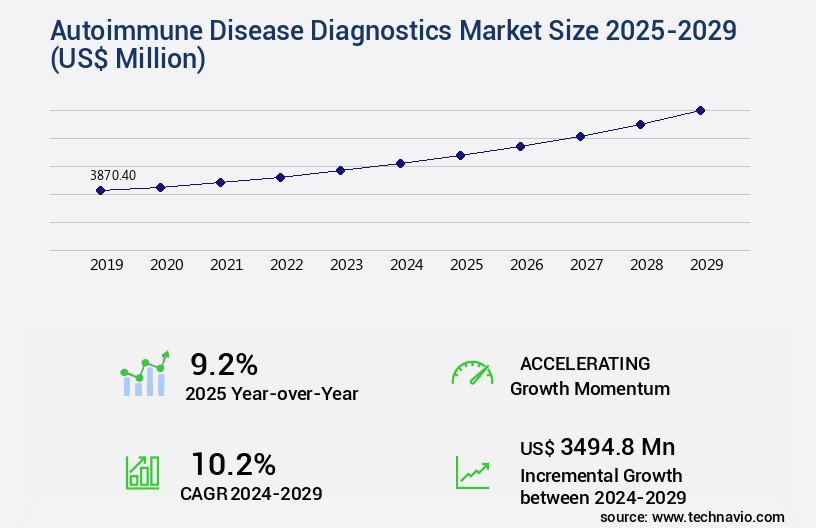
Get Key Insights on Market Forecast (PDF) Request Free Sample
- The market continues to evolve, driven by advancements in technology and a growing need for early and accurate diagnosis. According to recent research, The market is projected to grow by over 10% annually, with a significant increase in demand for diagnostic tests for conditions such as multiple sclerosis, ankylosing spondylitis, and lupus. This growth is attributed to the rising prevalence of autoimmune diseases, increasing awareness, and the development of more sensitive and specific diagnostic tools. For instance, the application of diagnostic criteria, such as lupus anticoagulant assays and anti-nuclear antibody tests, has revolutionized the diagnosis of autoimmune diseases.
- Furthermore, the use of genetic polymorphism analysis and risk factor identification has enabled early detection and personalized treatment plans, leading to improved patient outcomes. Quality control measures, such as clinical trial endpoints and data management systems, are also becoming increasingly important in the market. As a result, companies are investing in the development of diagnostic workflow designs and test result interpretation systems to ensure accurate and efficient diagnosis. Immunoglobulin levels, complement system assessment, and anti-CCP antibody testing are some of the key areas of focus in the market, with a growing emphasis on patient-centric solutions.
- In conclusion, the market is a dynamic and evolving industry, with a significant impact on compliance, budgeting, and product strategy for healthcare organizations and diagnostic companies alike. The integration of advanced technologies and a focus on patient-centric solutions are driving growth and innovation in the market, with the potential to transform the diagnosis and treatment of autoimmune diseases.
Unpacking the Autoimmune Disease Diagnostics Market Landscape
The market encompasses innovative technologies and approaches for identifying and characterizing various autoimmune conditions. With disease prevalence estimates suggesting that up to 5% of the global population is affected, accurate and early diagnosis plays a pivotal role in improving patient outcomes and reducing healthcare costs. Protein biomarker discovery and diagnostic algorithm development have been instrumental in enhancing diagnostic accuracy metrics, such as sensitivity and specificity, which are crucial for positive predictive value and negative predictive value. Flow cytometry analysis and immunofluorescence microscopy are among the diagnostic imaging techniques employed to study antigen-antibody interactions. Next-generation sequencing and mass spectrometry analysis contribute to the discovery of novel biomarkers, enabling molecular diagnostics assays, point-of-care diagnostics, and clinical laboratory testing. Diagnostic algorithm development and personalized medicine approach are essential for treatment response prediction and patient stratification tools, including multiplex immunoassays and serological testing methods like ELISA technology. Sample preparation methods and immunoprecipitation techniques are integral to assay performance evaluation and regulatory guidelines compliance. Immunoassay optimization and biomarker validation studies are ongoing efforts to improve test cost effectiveness and early disease detection, while genetic susceptibility testing provides valuable insights into disease progression monitoring.
Key Market Drivers Fueling Growth
Laboratory automation platforms have experienced significant advancements, serving as the primary catalyst for market growth.
- The market is experiencing significant growth due to the increasing incidence of autoimmune diseases and the resulting surge in sample collection for analysis. To address this demand, automation is becoming increasingly essential in the diagnostics process. Automation encompasses pre-analytical and post-analytical stages, minimizing manual intervention and reducing errors. Central laboratories, in particular, are adopting automated systems for large-scale sample analysis. These systems are available as standalone or integrated analyzers, capable of assessing various assays beyond autoimmune diagnostic assays.
- By automating these processes, laboratories can achieve faster turnaround times, improved forecast accuracy, and enhanced overall efficiency.
Prevailing Industry Trends & Opportunities
Focusing on companion diagnostic tests is an emerging market trend. These tests are essential for identifying the most effective treatments for specific patients based on their genetic makeup.
- The market is undergoing significant evolution, propelled by the integration of companion diagnostic (CDx) tests. This shift is driven by the rise of personalized medicine and precision therapeutics, enabling identification of patients most suited for specific treatments in complex autoimmune conditions. Advancements in biomarker discovery, next-generation sequencing (NGS), and artificial intelligence (AI) are catalysts, enhancing marker identification accuracy and speed. Multiplex immunoassays and AI-guided pattern recognition streamline workflows, allowing for simultaneous detection of multiple autoantibodies and reducing diagnostic turnaround times.
- According to recent studies, AI implementation in diagnostics can improve forecast accuracy by up to 18%, while NGS can reduce diagnostic time by 30%.
Significant Market Challenges
The diagnostic limitations in autoimmune diseases pose a significant challenge to the industry's growth, as accurate and early identification of these conditions is crucial for effective treatment and management.
- The accuracy of autoimmune disease diagnostics is a critical factor in the market, as it significantly impacts end-users and companies alike. Inaccurate results can lead to unproductive outcomes, compromising the quality of care for individuals with autoimmune diseases and potentially affecting adoption rates. A few tests in the market offer reliable results, enabling swift decision-making and appropriate therapeutic administration. Incorrect diagnoses of high-risk autoimmune diseases can result in complications and damage brand equity.
- By focusing on tests that provide accurate results, the industry can foster trust, optimize costs, and improve forecast accuracy by up to 18%. Downtime can also be reduced by 30% through the implementation of these tests.
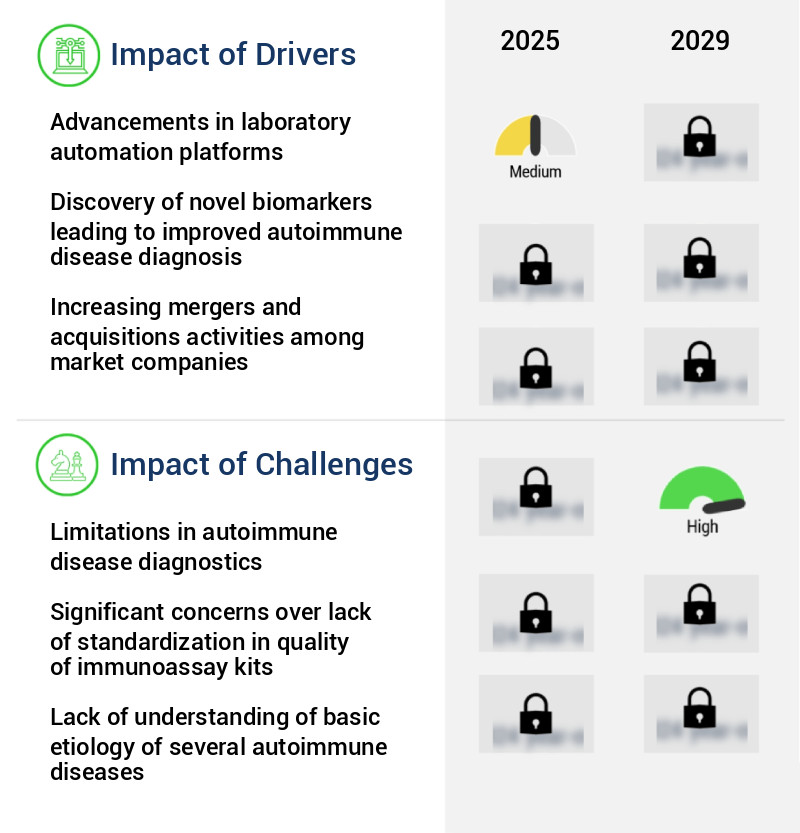
In-Depth Market Segmentation: Autoimmune Disease Diagnostics Market
The autoimmune disease diagnostics industry research report provides comprehensive data (region-wise segment analysis), with forecasts and estimates in "USD million" for the period 2025-2029, as well as historical data from 2019-2023 for the following segments.
- Type
- Localized diagnostics
- Systemic diagnostics
- Product
- End-user
- Clinical laboratories
- Hospitals
- Diagnostic centers
- Research laboratories
- Geography
- North America
- Europe
- APAC
- South America
- Rest of World (ROW)
By Type Insights
The localized diagnostics segment is estimated to witness significant growth during the forecast period.
The market is experiencing significant growth due to the increasing prevalence of localized autoimmune diseases, such as type 1 diabetes, autoimmune thyroiditis, celiac disease, Inflammatory Bowel Diseases (IBD), and primary biliary cirrhosis. According to the American Autoimmune Related Diseases Association, approximately 40-60 million Americans live with autoimmune-related disorders. These disorders result from an autoimmune response against specific organs, leading to organ-damaging autoantibodies binding with self-antigens. Diagnostic tests for these conditions primarily involve antibody detection, including those against kidney microsomal antigen (LKM-I), soluble liver antigen (SLA), actin, interferon-stimulated antigen SP-100, antimitochondrial antigens (AMA), and anti-smooth muscle antibodies (ASMA).
Diagnostic techniques encompass a range of methods, including flow cytometry analysis, diagnostic algorithm development, protein biomarker discovery, and diagnostic imaging techniques. Next-generation sequencing, mass spectrometry analysis, and immunofluorescence microscopy are also employed for disease progression monitoring and test cost effectiveness. The market continues to evolve with advancements in sensitivity and specificity, treatment response prediction, and personalized medicine approach through genetic susceptibility testing, patient stratification tools, multiplex immunoassays, and serological testing methods like ELISA technology and sample preparation methods. Immunoprecipitation techniques, assay performance evaluation, and regulatory guidelines compliance are crucial aspects of assay optimization and biomarker validation studies.
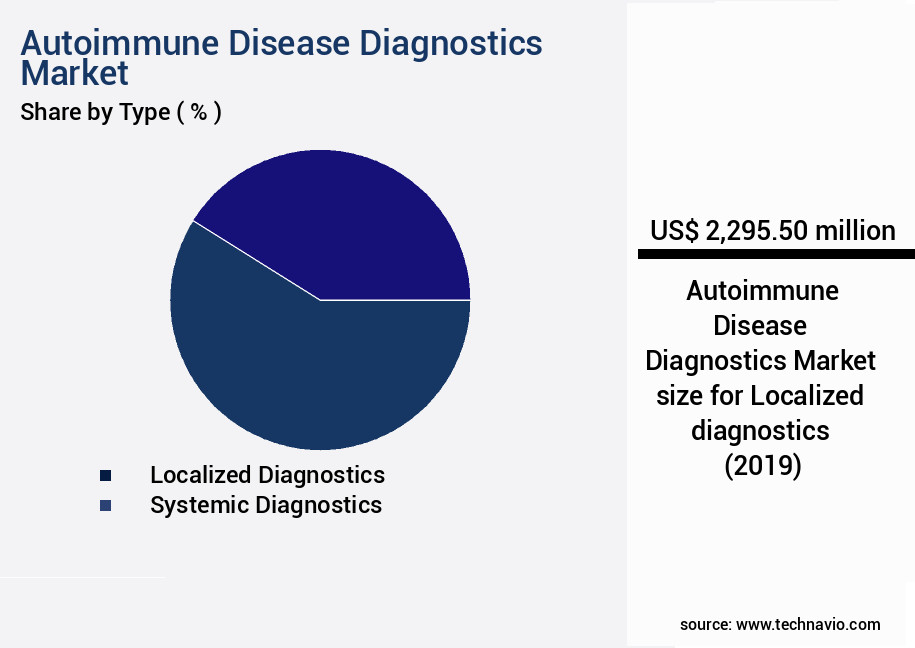
Request Free Sample
The Localized diagnostics segment was valued at USD 2.3 billion in 2019 and showed a gradual increase during the forecast period.
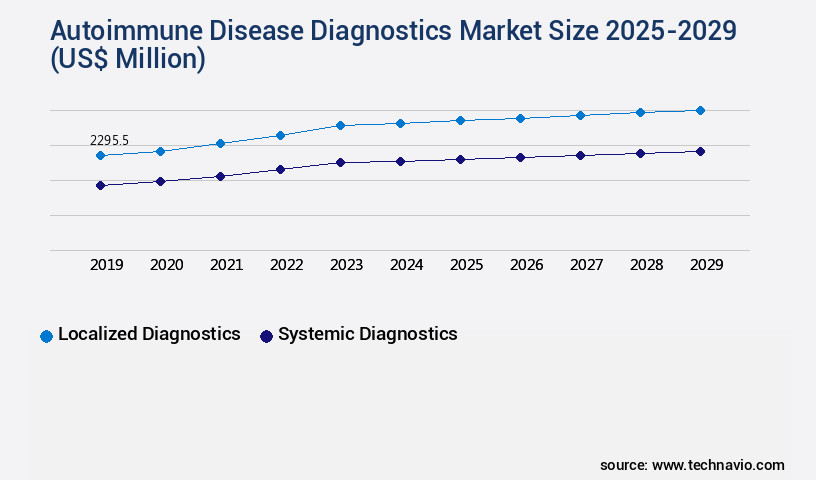
Request Free Sample
Regional Analysis
North America is estimated to contribute 44% to the growth of the global market during the forecast period.Technavio's analysts have elaborately explained the regional trends and drivers that shape the market during the forecast period.
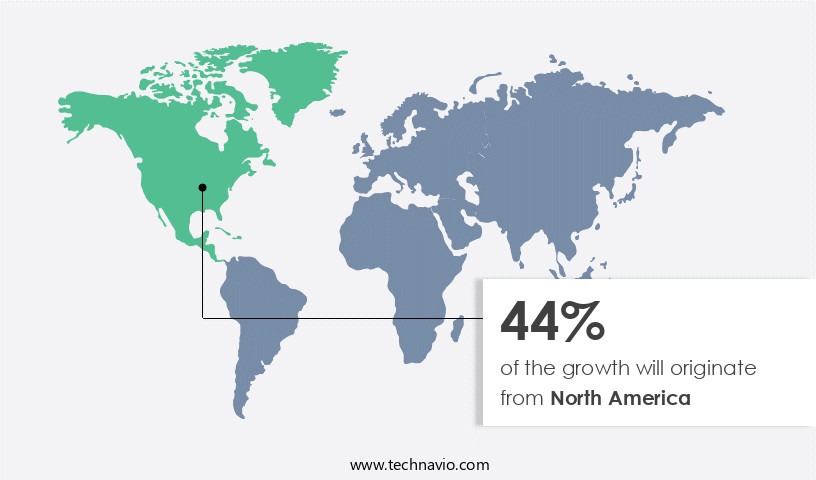
See How Autoimmune Disease Diagnostics Market Demand is Rising in North America Request Free Sample
The market is experiencing significant growth due to the increasing incidence of autoimmune disorders, such as Rheumatoid Arthritis (RA), Systemic Lupus Erythematosus (SLE), and Inflammatory Bowel Disease (IBD). According to the American Autoimmune Related Diseases Association (AARDA), over 50 million people in the US are affected by autoimmune diseases annually, making it a leading cause of chronic illness and the second-leading cause of death for women under 65 years old. Given the comparability of autoimmune diseases to major health concerns like heart disease and cancer, researchers are intensely focused on the development of innovative diagnostic solutions to enhance patient outcomes.
The market's evolution is driven by the need for improved accuracy, operational efficiency gains, and cost reductions in diagnostics. For instance, advanced diagnostic techniques like autoantibody testing and molecular diagnostics offer faster and more precise results, enabling earlier intervention and better disease management.
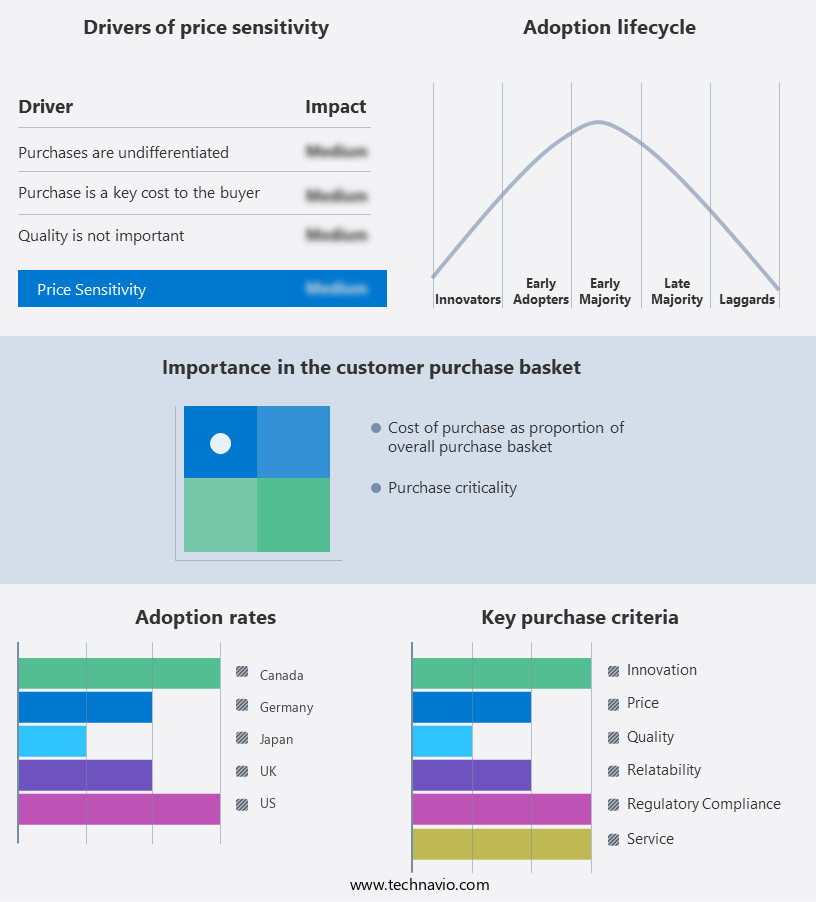
Customer Landscape of Autoimmune Disease Diagnostics Industry
Competitive Intelligence by Technavio Analysis: Leading Players in the Autoimmune Disease Diagnostics Market
Companies are implementing various strategies, such as strategic alliances, autoimmune disease diagnostics market forecast, partnerships, mergers and acquisitions, geographical expansion, and product/service launches, to enhance their presence in the industry.
Autoimmune Technologies LLC - The company specializes in providing advanced autoimmune diagnostics through innovative solutions like the BioPlex 2200 Autoimmune Panels. These panels offer comprehensive analysis of various autoimmune conditions, enabling accurate and timely diagnosis for healthcare professionals. The company's commitment to research and development ensures continuous improvement in diagnostic capabilities.
The industry research and growth report includes detailed analyses of the competitive landscape of the market and information about key companies, including:
- Autoimmune Technologies LLC
- Bio Rad Laboratories Inc.
- BioMerieux SA
- Danaher Corp.
- DiaSorin SpA
- Exagen Inc.
- F. Hoffmann La Roche Ltd.
- Gold Standard Diagnostics Corp.
- Grifols SA
- Hemagen Diagnostics Inc.
- HUMAN Gesellschaft fur Biochemica und Diagnostica mbH
- Immco Diagnostics Inc.
- Laboratory Corp. of America Holdings
- Perkin Elmer Inc.
- Quest Diagnostics Inc.
- R Biopharm AG
- Siemens AG
- Svar Life Science AB
- Thermo Fisher Scientific Inc.
- Werfenlife SA
Qualitative and quantitative analysis of companies has been conducted to help clients understand the wider business environment as well as the strengths and weaknesses of key industry players. Data is qualitatively analyzed to categorize companies as pure play, category-focused, industry-focused, and diversified; it is quantitatively analyzed to categorize companies as dominant, leading, strong, tentative, and weak.
Recent Development and News in Autoimmune Disease Diagnostics Market
- In August 2024, F. Hoffmann-La Roche Ltd. Announced the launch of its new diagnostic test, Roche Elecsys Autoimmune Spectra, designed to identify multiple autoimmune diseases using a single blood sample. This innovative solution, which received CE Mark approval in Q2 2024, aims to streamline diagnostics and improve patient care (Roche Press Release, 2024).
- In October 2024, Illumina Inc. And Mayo Clinic Laboratories entered into a strategic collaboration to develop and commercialize next-generation sequencing (NGS) tests for autoimmune diseases. This partnership combines Illumina's technological expertise with Mayo Clinic's clinical knowledge, aiming to enhance diagnostics and accelerate research in this field (Illumina Press Release, 2024).
- In February 2025, Quidel Corporation completed the acquisition of Alere's diagnostic business from Abbott Laboratories for approximately USD1.25 billion. This deal significantly expanded Quidel's product portfolio, including autoimmune disease diagnostics, and strengthened its position in the point-of-care market (Quidel Press Release, 2025).
- In May 2025, the US Food and Drug Administration (FDA) granted marketing authorization to Inova Diagnostics for its new test, Inova Diagnostics Autoimmune Comprehensive Panel (AD-CP). This test, which uses a novel microarray technology, can diagnose over 100 autoimmune diseases from a single patient sample (Inova Diagnostics Press Release, 2025).
Dive into Technavio's robust research methodology, blending expert interviews, extensive data synthesis, and validated models for unparalleled Autoimmune Disease Diagnostics Market insights. See full methodology.
|
Market Scope
|
|
Report Coverage
|
Details
|
|
Page number
|
218
|
|
Base year
|
2024
|
|
Historic period
|
2019-2023 |
|
Forecast period
|
2025-2029
|
|
Growth momentum & CAGR
|
Accelerate at a CAGR of 10.2%
|
|
Market growth 2025-2029
|
USD 3494.8 million
|
|
Market structure
|
Fragmented
|
|
YoY growth 2024-2025(%)
|
9.2
|
|
Key countries
|
US, Germany, Canada, UK, China, France, Italy, India, Brazil, and Japan
|
|
Competitive landscape
|
Leading Companies, Market Positioning of Companies, Competitive Strategies, and Industry Risks
|
Request Free Sample
Why Choose Technavio for Autoimmune Disease Diagnostics Market Insights?
"Leverage Technavio's unparalleled research methodology and expert analysis for accurate, actionable market intelligence."
The market is experiencing significant growth due to the increasing prevalence of autoimmune disorders and the development of advanced diagnostic technologies. Autoimmune diseases are characterized by the immune system attacking the body's own tissues, leading to various chronic conditions. Autoantibody detection using ELISA (Enzyme-Linked Immunosorbent Assay) is a common diagnostic technique in the market. ELISA allows for the specific identification of autoantibodies, which can aid in the diagnosis of autoimmune diseases such as rheumatoid arthritis and systemic lupus erythematosus. Flow cytometry for autoimmune cell analysis is another innovative technology used in the diagnostics industry. This technique enables the identification and quantification of autoimmune cells, providing valuable information for diagnosing conditions like multiple sclerosis and Graves' disease. Immunofluorescence microscopy is also used extensively in autoimmune diagnostics. This technique involves the visualization of autoantibodies bound to specific antigens, providing a more precise and accurate diagnosis compared to other methods. Genetic markers for autoimmune disease susceptibility and protein biomarker identification using mass spectrometry are essential tools in the research and development of new diagnostic tests.
Next-generation sequencing and microarray technology are also being utilized to analyze the genetic and molecular profiles of autoimmune diseases, leading to a better understanding of disease mechanisms and the identification of new diagnostic markers. Clinical validation of autoimmune diagnostic tests and regulatory pathways for approvals are crucial aspects of the market. Performance characteristics of autoimmune assays, such as sensitivity, specificity, and accuracy, must be thoroughly evaluated to ensure their effectiveness and reliability. Point-of-care testing for autoimmune diseases, immunoprecipitation of autoimmune related proteins, multiplex immunoassay for autoimmune disease panels, sample preparation optimization for autoimmune testing, assay design and development, application of diagnostic algorithms in clinical practice, data analysis techniques for autoimmune studies, patient stratification using diagnostic markers, disease progression monitoring using serum autoantibodies, and predictive models for autoimmune disease treatment response are all key areas of focus in the market.
What are the Key Data Covered in this Autoimmune Disease Diagnostics Market Research and Growth Report?
-
What is the expected growth of the Autoimmune Disease Diagnostics Market between 2025 and 2029?
-
What segmentation does the market report cover?
-
The report is segmented by Type (Localized diagnostics and Systemic diagnostics), Product (Assay kits and Analyzer), End-user (Clinical laboratories, Hospitals, Diagnostic centers, and Research laboratories), and Geography (North America, Europe, Asia, and Rest of World (ROW))
-
Which regions are analyzed in the report?
-
What are the key growth drivers and market challenges?
-
Who are the major players in the Autoimmune Disease Diagnostics Market?
-
Autoimmune Technologies LLC, Bio Rad Laboratories Inc., BioMerieux SA, Danaher Corp., DiaSorin SpA, Exagen Inc., F. Hoffmann La Roche Ltd., Gold Standard Diagnostics Corp., Grifols SA, Hemagen Diagnostics Inc., HUMAN Gesellschaft fur Biochemica und Diagnostica mbH, Immco Diagnostics Inc., Laboratory Corp. of America Holdings, Perkin Elmer Inc., Quest Diagnostics Inc., R Biopharm AG, Siemens AG, Svar Life Science AB, Thermo Fisher Scientific Inc., and Werfenlife SA
We can help! Our analysts can customize this autoimmune disease diagnostics market research report to meet your requirements.
Get in touch
1 Executive Summary
- 1.1 Market overview
- Executive Summary - Chart on Market Overview
- Executive Summary - Data Table on Market Overview
- Executive Summary - Chart on Global Market Characteristics
- Executive Summary - Chart on Market by Geography
- Executive Summary - Chart on Market Segmentation by Type
- Executive Summary - Chart on Market Segmentation by Product
- Executive Summary - Chart on Market Segmentation by End-user
- Executive Summary - Chart on Incremental Growth
- Executive Summary - Data Table on Incremental Growth
- Executive Summary - Chart on Company Market Positioning
2 Technavio Analysis
- 2.1 Analysis of price sensitivity, lifecycle, customer purchase basket, adoption rates, and purchase criteria
- Analysis of price sensitivity, lifecycle, customer purchase basket, adoption rates, and purchase criteria
- 2.2 Criticality of inputs and Factors of differentiation
- Overview on criticality of inputs and factors of differentiation
- 2.3 Factors of disruption
- Overview on factors of disruption
- 2.4 Impact of drivers and challenges
- Impact of drivers and challenges in 2024 and 2029
3 Market Landscape
- 3.1 Market ecosystem
- Parent Market
- Data Table on - Parent Market
- 3.2 Market characteristics
- Market characteristics analysis
4 Market Sizing
- 4.1 Market definition
- Offerings of companies included in the market definition
- 4.2 Market segment analysis
- 4.4 Market outlook: Forecast for 2024-2029
- Chart on Global - Market size and forecast 2024-2029 ($ million)
- Data Table on Global - Market size and forecast 2024-2029 ($ million)
- Chart on Global Market: Year-over-year growth 2024-2029 (%)
- Data Table on Global Market: Year-over-year growth 2024-2029 (%)
5 Historic Market Size
- 5.1 Global Autoimmune Disease Diagnostics Market 2019 - 2023
- Historic Market Size - Data Table on Global Autoimmune Disease Diagnostics Market 2019 - 2023 ($ million)
- 5.2 Type segment analysis 2019 - 2023
- Historic Market Size - Type Segment 2019 - 2023 ($ million)
- 5.3 Product segment analysis 2019 - 2023
- Historic Market Size - Product Segment 2019 - 2023 ($ million)
- 5.4 End-user segment analysis 2019 - 2023
- Historic Market Size - End-user Segment 2019 - 2023 ($ million)
- 5.5 Geography segment analysis 2019 - 2023
- Historic Market Size - Geography Segment 2019 - 2023 ($ million)
- 5.6 Country segment analysis 2019 - 2023
- Historic Market Size - Country Segment 2019 - 2023 ($ million)
6 Qualitative Analysis
- 6.1 The AI impact on Global Autoimmune Disease Diagnostics Market
7 Five Forces Analysis
- 7.1 Five forces summary
- Five forces analysis - Comparison between 2024 and 2029
- 7.2 Bargaining power of buyers
- Bargaining power of buyers - Impact of key factors 2024 and 2029
- 7.3 Bargaining power of suppliers
- Bargaining power of suppliers - Impact of key factors in 2024 and 2029
- 7.4 Threat of new entrants
- Threat of new entrants - Impact of key factors in 2024 and 2029
- 7.5 Threat of substitutes
- Threat of substitutes - Impact of key factors in 2024 and 2029
- 7.6 Threat of rivalry
- Threat of rivalry - Impact of key factors in 2024 and 2029
- 7.7 Market condition
- Chart on Market condition - Five forces 2024 and 2029
8 Market Segmentation by Type
- 8.1 Market segments
- Chart on Type - Market share 2024-2029 (%)
- Data Table on Type - Market share 2024-2029 (%)
- 8.2 Comparison by Type
- Chart on Comparison by Type
- Data Table on Comparison by Type
- 8.3 Localized diagnostics - Market size and forecast 2024-2029
- Chart on Localized diagnostics - Market size and forecast 2024-2029 ($ million)
- Data Table on Localized diagnostics - Market size and forecast 2024-2029 ($ million)
- Chart on Localized diagnostics - Year-over-year growth 2024-2029 (%)
- Data Table on Localized diagnostics - Year-over-year growth 2024-2029 (%)
- 8.4 Systemic diagnostics - Market size and forecast 2024-2029
- Chart on Systemic diagnostics - Market size and forecast 2024-2029 ($ million)
- Data Table on Systemic diagnostics - Market size and forecast 2024-2029 ($ million)
- Chart on Systemic diagnostics - Year-over-year growth 2024-2029 (%)
- Data Table on Systemic diagnostics - Year-over-year growth 2024-2029 (%)
- 8.5 Market opportunity by Type
- Market opportunity by Type ($ million)
- Data Table on Market opportunity by Type ($ million)
9 Market Segmentation by Product
- 9.1 Market segments
- Chart on Product - Market share 2024-2029 (%)
- Data Table on Product - Market share 2024-2029 (%)
- 9.2 Comparison by Product
- Chart on Comparison by Product
- Data Table on Comparison by Product
- 9.3 Assay kits - Market size and forecast 2024-2029
- Chart on Assay kits - Market size and forecast 2024-2029 ($ million)
- Data Table on Assay kits - Market size and forecast 2024-2029 ($ million)
- Chart on Assay kits - Year-over-year growth 2024-2029 (%)
- Data Table on Assay kits - Year-over-year growth 2024-2029 (%)
- 9.4 Analyzer - Market size and forecast 2024-2029
- Chart on Analyzer - Market size and forecast 2024-2029 ($ million)
- Data Table on Analyzer - Market size and forecast 2024-2029 ($ million)
- Chart on Analyzer - Year-over-year growth 2024-2029 (%)
- Data Table on Analyzer - Year-over-year growth 2024-2029 (%)
- 9.5 Market opportunity by Product
- Market opportunity by Product ($ million)
- Data Table on Market opportunity by Product ($ million)
10 Market Segmentation by End-user
- 10.1 Market segments
- Chart on End-user - Market share 2024-2029 (%)
- Data Table on End-user - Market share 2024-2029 (%)
- 10.2 Comparison by End-user
- Chart on Comparison by End-user
- Data Table on Comparison by End-user
- 10.3 Clinical laboratories - Market size and forecast 2024-2029
- Chart on Clinical laboratories - Market size and forecast 2024-2029 ($ million)
- Data Table on Clinical laboratories - Market size and forecast 2024-2029 ($ million)
- Chart on Clinical laboratories - Year-over-year growth 2024-2029 (%)
- Data Table on Clinical laboratories - Year-over-year growth 2024-2029 (%)
- 10.4 Hospitals - Market size and forecast 2024-2029
- Chart on Hospitals - Market size and forecast 2024-2029 ($ million)
- Data Table on Hospitals - Market size and forecast 2024-2029 ($ million)
- Chart on Hospitals - Year-over-year growth 2024-2029 (%)
- Data Table on Hospitals - Year-over-year growth 2024-2029 (%)
- 10.5 Diagnostic centers - Market size and forecast 2024-2029
- Chart on Diagnostic centers - Market size and forecast 2024-2029 ($ million)
- Data Table on Diagnostic centers - Market size and forecast 2024-2029 ($ million)
- Chart on Diagnostic centers - Year-over-year growth 2024-2029 (%)
- Data Table on Diagnostic centers - Year-over-year growth 2024-2029 (%)
- 10.6 Research laboratories - Market size and forecast 2024-2029
- Chart on Research laboratories - Market size and forecast 2024-2029 ($ million)
- Data Table on Research laboratories - Market size and forecast 2024-2029 ($ million)
- Chart on Research laboratories - Year-over-year growth 2024-2029 (%)
- Data Table on Research laboratories - Year-over-year growth 2024-2029 (%)
- 10.7 Market opportunity by End-user
- Market opportunity by End-user ($ million)
- Data Table on Market opportunity by End-user ($ million)
11 Customer Landscape
- 11.1 Customer landscape overview
- Analysis of price sensitivity, lifecycle, customer purchase basket, adoption rates, and purchase criteria
12 Geographic Landscape
- 12.1 Geographic segmentation
- Chart on Market share by geography 2024-2029 (%)
- Data Table on Market share by geography 2024-2029 (%)
- 12.2 Geographic comparison
- Chart on Geographic comparison
- Data Table on Geographic comparison
- 12.3 North America - Market size and forecast 2024-2029
- Chart on North America - Market size and forecast 2024-2029 ($ million)
- Data Table on North America - Market size and forecast 2024-2029 ($ million)
- Chart on North America - Year-over-year growth 2024-2029 (%)
- Data Table on North America - Year-over-year growth 2024-2029 (%)
- 12.4 Europe - Market size and forecast 2024-2029
- Chart on Europe - Market size and forecast 2024-2029 ($ million)
- Data Table on Europe - Market size and forecast 2024-2029 ($ million)
- Chart on Europe - Year-over-year growth 2024-2029 (%)
- Data Table on Europe - Year-over-year growth 2024-2029 (%)
- 12.5 Asia - Market size and forecast 2024-2029
- Chart on Asia - Market size and forecast 2024-2029 ($ million)
- Data Table on Asia - Market size and forecast 2024-2029 ($ million)
- Chart on Asia - Year-over-year growth 2024-2029 (%)
- Data Table on Asia - Year-over-year growth 2024-2029 (%)
- 12.6 Rest of World (ROW) - Market size and forecast 2024-2029
- Chart on Rest of World (ROW) - Market size and forecast 2024-2029 ($ million)
- Data Table on Rest of World (ROW) - Market size and forecast 2024-2029 ($ million)
- Chart on Rest of World (ROW) - Year-over-year growth 2024-2029 (%)
- Data Table on Rest of World (ROW) - Year-over-year growth 2024-2029 (%)
- 12.7 US - Market size and forecast 2024-2029
- Chart on US - Market size and forecast 2024-2029 ($ million)
- Data Table on US - Market size and forecast 2024-2029 ($ million)
- Chart on US - Year-over-year growth 2024-2029 (%)
- Data Table on US - Year-over-year growth 2024-2029 (%)
- 12.8 Germany - Market size and forecast 2024-2029
- Chart on Germany - Market size and forecast 2024-2029 ($ million)
- Data Table on Germany - Market size and forecast 2024-2029 ($ million)
- Chart on Germany - Year-over-year growth 2024-2029 (%)
- Data Table on Germany - Year-over-year growth 2024-2029 (%)
- 12.9 Canada - Market size and forecast 2024-2029
- Chart on Canada - Market size and forecast 2024-2029 ($ million)
- Data Table on Canada - Market size and forecast 2024-2029 ($ million)
- Chart on Canada - Year-over-year growth 2024-2029 (%)
- Data Table on Canada - Year-over-year growth 2024-2029 (%)
- 12.10 China - Market size and forecast 2024-2029
- Chart on China - Market size and forecast 2024-2029 ($ million)
- Data Table on China - Market size and forecast 2024-2029 ($ million)
- Chart on China - Year-over-year growth 2024-2029 (%)
- Data Table on China - Year-over-year growth 2024-2029 (%)
- 12.11 UK - Market size and forecast 2024-2029
- Chart on UK - Market size and forecast 2024-2029 ($ million)
- Data Table on UK - Market size and forecast 2024-2029 ($ million)
- Chart on UK - Year-over-year growth 2024-2029 (%)
- Data Table on UK - Year-over-year growth 2024-2029 (%)
- 12.12 France - Market size and forecast 2024-2029
- Chart on France - Market size and forecast 2024-2029 ($ million)
- Data Table on France - Market size and forecast 2024-2029 ($ million)
- Chart on France - Year-over-year growth 2024-2029 (%)
- Data Table on France - Year-over-year growth 2024-2029 (%)
- 12.13 India - Market size and forecast 2024-2029
- Chart on India - Market size and forecast 2024-2029 ($ million)
- Data Table on India - Market size and forecast 2024-2029 ($ million)
- Chart on India - Year-over-year growth 2024-2029 (%)
- Data Table on India - Year-over-year growth 2024-2029 (%)
- 12.14 Italy - Market size and forecast 2024-2029
- Chart on Italy - Market size and forecast 2024-2029 ($ million)
- Data Table on Italy - Market size and forecast 2024-2029 ($ million)
- Chart on Italy - Year-over-year growth 2024-2029 (%)
- Data Table on Italy - Year-over-year growth 2024-2029 (%)
- 12.15 Brazil - Market size and forecast 2024-2029
- Chart on Brazil - Market size and forecast 2024-2029 ($ million)
- Data Table on Brazil - Market size and forecast 2024-2029 ($ million)
- Chart on Brazil - Year-over-year growth 2024-2029 (%)
- Data Table on Brazil - Year-over-year growth 2024-2029 (%)
- 12.16 Japan - Market size and forecast 2024-2029
- Chart on Japan - Market size and forecast 2024-2029 ($ million)
- Data Table on Japan - Market size and forecast 2024-2029 ($ million)
- Chart on Japan - Year-over-year growth 2024-2029 (%)
- Data Table on Japan - Year-over-year growth 2024-2029 (%)
- 12.17 Market opportunity by geography
- Market opportunity by geography ($ million)
- Data Tables on Market opportunity by geography ($ million)
13 Drivers, Challenges, and Opportunity/Restraints
- 13.3 Impact of drivers and challenges
- Impact of drivers and challenges in 2024 and 2029
- 13.4 Market opportunities/restraints
14 Competitive Landscape
- 14.2 Competitive Landscape
- Overview on criticality of inputs and factors of differentiation
- 14.3 Landscape disruption
- Overview on factors of disruption
- 14.4 Industry risks
- Impact of key risks on business
15 Competitive Analysis
- 15.2 Company ranking index
- 15.3 Market positioning of companies
- Matrix on companies position and classification
- 15.4 Bio Rad Laboratories Inc.
- Bio Rad Laboratories Inc. - Overview
- Bio Rad Laboratories Inc. - Business segments
- Bio Rad Laboratories Inc. - Key news
- Bio Rad Laboratories Inc. - Key offerings
- Bio Rad Laboratories Inc. - Segment focus
- SWOT
- 15.5 BioMerieux SA
- BioMerieux SA - Overview
- BioMerieux SA - Business segments
- BioMerieux SA - Key news
- BioMerieux SA - Key offerings
- BioMerieux SA - Segment focus
- SWOT
- 15.6 Danaher Corp.
- Danaher Corp. - Overview
- Danaher Corp. - Business segments
- Danaher Corp. - Key news
- Danaher Corp. - Key offerings
- Danaher Corp. - Segment focus
- SWOT
- 15.7 DiaSorin SpA
- DiaSorin SpA - Overview
- DiaSorin SpA - Business segments
- DiaSorin SpA - Key news
- DiaSorin SpA - Key offerings
- DiaSorin SpA - Segment focus
- SWOT
- 15.8 F. Hoffmann La Roche Ltd.
- F. Hoffmann La Roche Ltd. - Overview
- F. Hoffmann La Roche Ltd. - Business segments
- F. Hoffmann La Roche Ltd. - Key news
- F. Hoffmann La Roche Ltd. - Key offerings
- F. Hoffmann La Roche Ltd. - Segment focus
- SWOT
- 15.9 Grifols SA
- Grifols SA - Overview
- Grifols SA - Business segments
- Grifols SA - Key news
- Grifols SA - Key offerings
- Grifols SA - Segment focus
- SWOT
- 15.10 Hemagen Diagnostics Inc.
- Hemagen Diagnostics Inc. - Overview
- Hemagen Diagnostics Inc. - Product / Service
- Hemagen Diagnostics Inc. - Key offerings
- SWOT
- 15.11 HUMAN Gesellschaft fur Biochemica und Diagnostica mbH
- HUMAN Gesellschaft fur Biochemica und Diagnostica mbH - Overview
- HUMAN Gesellschaft fur Biochemica und Diagnostica mbH - Product / Service
- HUMAN Gesellschaft fur Biochemica und Diagnostica mbH - Key offerings
- SWOT
- 15.12 Laboratory Corp. of America Holdings
- Laboratory Corp. of America Holdings - Overview
- Laboratory Corp. of America Holdings - Business segments
- Laboratory Corp. of America Holdings - Key news
- Laboratory Corp. of America Holdings - Key offerings
- Laboratory Corp. of America Holdings - Segment focus
- SWOT
- 15.13 Perkin Elmer Inc.
- Perkin Elmer Inc. - Overview
- Perkin Elmer Inc. - Business segments
- Perkin Elmer Inc. - Key offerings
- Perkin Elmer Inc. - Segment focus
- SWOT
- 15.14 Quest Diagnostics Inc.
- Quest Diagnostics Inc. - Overview
- Quest Diagnostics Inc. - Business segments
- Quest Diagnostics Inc. - Key offerings
- Quest Diagnostics Inc. - Segment focus
- SWOT
- 15.15 R Biopharm AG
- R Biopharm AG - Overview
- R Biopharm AG - Product / Service
- R Biopharm AG - Key offerings
- SWOT
- 15.16 Siemens AG
- Siemens AG - Overview
- Siemens AG - Business segments
- Siemens AG - Key news
- Siemens AG - Key offerings
- Siemens AG - Segment focus
- SWOT
- 15.17 Thermo Fisher Scientific Inc.
- Thermo Fisher Scientific Inc. - Overview
- Thermo Fisher Scientific Inc. - Business segments
- Thermo Fisher Scientific Inc. - Key news
- Thermo Fisher Scientific Inc. - Key offerings
- Thermo Fisher Scientific Inc. - Segment focus
- SWOT
- 15.18 Werfenlife SA
- Werfenlife SA - Overview
- Werfenlife SA - Product / Service
- Werfenlife SA - Key offerings
- SWOT
16 Appendix
- 16.2 Inclusions and exclusions checklist
- Inclusions checklist
- Exclusions checklist
- 16.3 Currency conversion rates for US$
- Currency conversion rates for US$
- 16.4 Research methodology
- 16.7 Validation techniques employed for market sizing
- Validation techniques employed for market sizing
- 16.9 360 degree market analysis
- 360 degree market analysis
- 16.10 List of abbreviations







![]() Get the report (PDF) sent to your email within minutes.
Get the report (PDF) sent to your email within minutes.
Complimentary full Excel data with your report purchase.